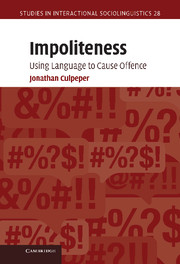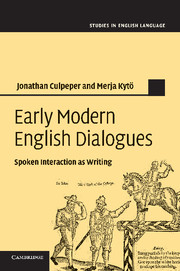Impoliteness
When is language considered 'impolite'? Is impolite language only used for anti-social purposes? Can impolite language be creative? What is the difference between 'impoliteness' and 'rudeness'? Grounded in naturally-occurring language data and drawing on findings from linguistic pragmatics and social psychology, Jonathan Culpeper provides a fascinating account of how impolite behaviour works. He examines not only its forms and functions but also people's understandings of it in both public and private contexts. He reveals, for example, the emotional consequences of impoliteness, how it shapes and is shaped by contexts, and how it is sometimes institutionalised. This book offers penetrating insights into a hitherto neglected and poorly understood phenomenon. It will be welcomed by students and researchers in linguistics and social psychology in particular.
- A highly revealing account of a hitherto neglected and poorly understood phenomenon
- Numerous examples from everyday conversation help to highlight how impolite language is used
- Draws on findings from social psychology and linguistic pragmatics, providing a truly multidisciplinary account
Reviews & endorsements
"Culpeper’s outstanding book documents that the time is ripe for us to address the urgent social problem of violence in language. In proposing an insightful theory of impoliteness, Culpeper accurately reads classic and contemporary linguistic theories and analyses a wide range of oral and written impoliteness events."
Daniel Silva, Journal of Language Aggression and Conflict
Product details
February 2011Hardback
9780521869676
308 pages
235 × 155 × 20 mm
0.62kg
19 b/w illus. 23 tables
Available
Table of Contents
- Introducing impoliteness
- 1. Understanding impoliteness I: face and social norms
- 2. Understanding impoliteness II: intentionality and emotions
- 3. Impoliteness metadiscourse
- 4. Conventionalised formulaic impoliteness and its intensification
- 5. Non-conventionalised impoliteness: implicational impoliteness
- 6. Impoliteness events: co-texts and contexts
- 7. Impoliteness events: functions
- 8. Conclusions.







